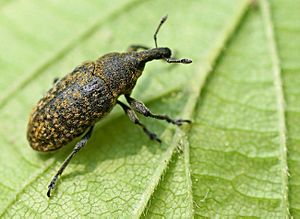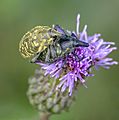Larinus planus facts for kids
Quick facts for kids Larinus planus |
|
|---|---|
 |
|
| Scientific classification | |
| Kingdom: | |
| Phylum: | |
| Class: | |
| Order: | |
| Family: | |
| Subfamily: |
Lixinae
|
| Genus: |
Larinus
|
| Species: |
L. planus
|
| Binomial name | |
| Larinus planus (Fabricius, 1792)
|
|
Larinus planus is a type of weevil, which is a small insect with a long snout. It belongs to the Curculionidae family. This little beetle is originally from Europe. But it has also become very common in North America. Both the young weevils (called larvae) and the adult weevils love to munch on flower buds. They especially like the buds of thistle plants. These weevils are usually oval-shaped and dark brown or black. They are quite small, about 5 to 10 millimeters long.
Contents
What Larinus planus Looks Like
Larinus planus weevils are easy to spot if you know what to look for. They have an oval body shape. Their color is usually a dark brown or black. They are quite small, measuring only about 5 to 10 millimeters in length. This is roughly the size of a grain of rice.
Life Cycle and What They Eat
The life of a Larinus planus weevil starts as an egg. The eggs hatch into larvae, which are like tiny grubs. These larvae are the ones that cause the most harm to plants. They live inside the flower buds and eat them from the inside out. This stops the flower from making seeds.
Both the larvae and the adult weevils feed on flower buds. They mostly eat the buds of thistle plants.
Using Weevils for Plant Control
In North America, Larinus planus has been used as a biocontrol agent. This means it was brought in on purpose to help control other unwanted plants. The idea was to use these weevils to stop the spread of certain invasive thistles.
One main target was the Canada thistle. This thistle can grow very fast and take over fields. By eating the flower buds, the weevils could reduce the number of seeds the thistle produced. This would help slow down its spread.
Unexpected Spread and Problems
However, sometimes using a biocontrol agent can have unexpected results. Larinus planus has spread to other plants that it was not supposed to eat. For example, in 2000, it was found eating Cirsium undulatum. This is a type of thistle that is native to western Colorado and eastern Utah.
Later research showed that the weevil had reduced the number of seeds produced by this native thistle. It has also been found to harm Cirsium pitcheri. This is another native thistle that is important for its ecosystem.
It is common for introduced species to spread quickly. This happens because they often do not have their natural parasites or predators in their new home. Without these natural enemies, their numbers can grow very fast.
Images for kids
See also
 In Spanish: Larinus carlinae para niños
In Spanish: Larinus carlinae para niños


